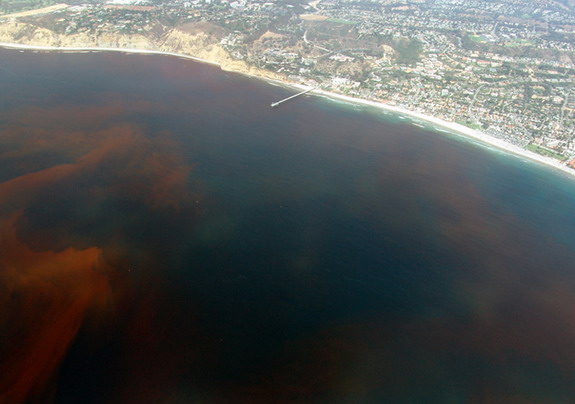I think it was ‘Ol Casey, although it might have been Yogi, who once said, “hit it where they ain’t.” Much of fishin’ is learning to cast it where they is! Luckily there is usually some type of fish around a pier at all times—with one exception. That exception is the dreaded “red tide.” This nasty little condition develops when tiny (really, really tiny) organisms called dinoflagellates start to multiply at a phenomenal rate (bloom) and saturate the water with their itsy bitsy bodies. Millions of these dinoflagellates, and there are several different types, may exist in a single liter of water. If it is only a half-million to a million per liter of water, the coloring may be brown (or yellowish), if it hits the maximum concentration of 50 million per liter, the water will have a distinctly reddish color. Imagine a liter bottle containing 50 million little Lenins or Stalins (commies/reds—get it?). If you’re non-political, imagine 50 million tiny little red rockfish squeezed into one of those liter-size bottles. Unfortunately, as the number of these organisms increase they begin to use up the oxygen in the water. At the upper number limits, the dissolved oxygen in the water drops virtually to zero. Initially, as the water quality begins to decrease, the more mobile organisms (like fish) begin to leave the area. Eventually, as the water reaches zero oxygen levels, death results to the creatures still in the area.
Occasionally the result is a massive “die off” of fish. One of the most famous in California occurred in 1964 when an estimated 50 tons of anchovies became trapped in Santa Cruz Harbor during a “red tide” invasion (dinoflagellate counts of Gonyaulax polydera reached 20-35 million per liter). The fish died, the smell was unbearable, and oil from the bodies of the decaying anchovies pitted the hulls of boats in the harbor. There have been many such occurrences in California, some recorded back to the 1800s. Obviously, conditions such as this are bad for our trusty pier fisherman. Any fish with half an ounce of brain (poor simile) would try to swim away to cleaner water. If it is a small bloom that may be possible, if it is a large bloom (one reported off Mexico extended 170 miles) it may be impossible. So, the angler who casts his line out into the waters of a “red tide” is faced with two possibilities: The first is that there are few fish present—since most have moved to safer areas. The second possibility is that there are no fish in the area—they’re dead. In either case the angler would be wise to move on.
Unfortunately, scientists report that the number of “red tides” seems to be increasing, especially in the man-made harbors in southern California. Often these enclosed waters exhibit poor circulation and semi-stagnant conditions, which can act as fish traps during blooms. My observations would tend to confirm these scientific beliefs. Although I have seen “red tide” conditions at almost every pier in southern California, and at the Cayucos Pier in central California, the pier which seems to see these conditions most often is the Belmont Pier in Long Beach. The Belmont Pier sits inside the protected breakwater of the Los Angeles Harbor and receives less movement of water than oceanfront piers.
Luckily most of these blooms don’t last too long and most are fairly small. Once the oxygen level reaches zero the plankton themselves begins to die (and the decomposition of the plankton uses up even more oxygen). With the death of the dinoflagellates, the recovery of the water can begin. Sometimes one part of a pier’s water may be covered while another part exhibits no bloom. Sometimes the bloom is mainly on the top of the water while water underneath is freer of the organisms. Sometimes the entire pier is surrounded with “red tide.” If the pier’s water has a reddish appearance, fish will probably be absent. If the water is more of a brownish appearance you may catch fish, but probably not too many. If the bloom is in patches around the pier, and you can’t stop yourself from “giving it a try,” try fishing in the clearer water where fish may still be present. However, the best advice is simply to avoid fishing from a pier that appears to have “red tide” conditions. A ninth rule might be that if a pier is surrounded with red water, pretend it is a stop sign, and go no further.
Just so you poor pier fisherman don’t feel like you’re being picked on, it should be reported that some scientists feel that the story of Moses, the pharaoh, and the red Nile were simply a “red tide” condition. You do remember when the Nile turned to the color of blood, fish died, and the water was undrinkable—don’t you? Check out the book of Exodus in the Bible.
By the way, dinoflagellates are the same organisms that make it unsafe to eat mussels during certain months of the year in California and lead to prohibitions on the taking of shellfish, generally May 1 to October 31. However, these are a different and more toxic species than those that cause “red tide.” And, just so I don’t flunk the baseball exam, turns out it wasn’t Casey or Yogi who made the statement that opens this section. A Pier Rat informed me that it goes all the way back to “Wee Willie” Keeler. Guess I should stick to fishing.
—From Pier Fishing in California, 2nd Ed.

















in oct.2011 red tide was thick out of the golden gate on a charter boat i was on. we all caught our limits of salmon to 32lbs. but what was most unusual was that the salmon which should not have been feeding that late in the season were stuffed with a type of bait fish normally not seen [according to the skipper] north of san diego. they looked like little barracuda.